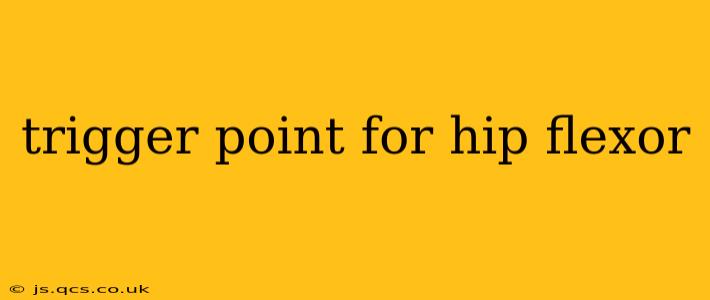The hip flexor muscles are a crucial group responsible for flexing the hip, allowing you to lift your knees toward your chest. Tight or strained hip flexors are incredibly common, often leading to pain, discomfort, and reduced mobility. A significant contributor to this discomfort is the presence of myofascial trigger points (TrPs). These are hyperirritable spots within the muscle that cause localized pain and can refer pain to other areas. Understanding the location, symptoms, and treatment options for hip flexor trigger points is key to effective relief.
What are Hip Flexor Trigger Points?
Myofascial trigger points are knots or bands of tight muscle fibers that develop within a muscle. In the case of the hip flexor, these trigger points can develop in several muscles, including the:
- Iliopsoas: This is the primary hip flexor, made up of the psoas major, psoas minor, and iliacus muscles. Trigger points here often refer pain to the groin, inner thigh, and lower back.
- Rectus Femoris: Part of the quadriceps group, the rectus femoris also crosses the hip joint and contributes to hip flexion. Trigger points here can radiate pain to the front of the thigh and even the knee.
- Tensor Fasciae Latae (TFL): Located on the outer hip, the TFL assists with hip flexion and abduction (moving the leg away from the body). Trigger points in the TFL often cause pain in the outer hip and buttock.
Where are Hip Flexor Trigger Points Located?
The precise location of trigger points can vary, but they generally reside within the belly of the muscle. For example:
- Iliopsoas Trigger Points: Often found deep within the abdomen, near the groin and sometimes felt when palpating deep in the lower abdomen.
- Rectus Femoris Trigger Points: Usually found in the central portion of the muscle, along the front of the thigh.
- TFL Trigger Points: Typically located along the outer side of the hip, slightly below the iliac crest (the bony prominence of the hip).
It's crucial to note: Self-diagnosing trigger points can be challenging. If you suspect you have hip flexor trigger points, consulting a physical therapist or other qualified healthcare professional is recommended for accurate diagnosis and treatment.
What are the Symptoms of Hip Flexor Trigger Points?
Symptoms can vary depending on the muscle affected and the location of the trigger point. However, common symptoms include:
- Localized pain: A sharp, aching, or burning pain in the hip flexor area.
- Referred pain: Pain radiating to other areas, such as the groin, inner thigh, lower back, buttock, or front of the thigh, depending on the specific muscle.
- Muscle stiffness and tightness: Difficulty flexing the hip or extending the leg.
- Reduced range of motion: Limited ability to perform activities requiring hip flexion, such as walking, climbing stairs, or bending down.
- Muscle weakness: Weakness in the affected leg.
How do you know if your hip pain is from a trigger point?
Differentiating hip pain from a trigger point versus other causes like arthritis or a hip labral tear requires a professional evaluation. A physical therapist can perform a thorough examination to pinpoint the source of your pain. They may use palpation to identify tender points within the muscle, assess your range of motion, and conduct functional movement tests to establish a diagnosis.
What causes hip flexor trigger points?
Several factors can contribute to the development of hip flexor trigger points:
- Prolonged sitting: A sedentary lifestyle and prolonged sitting can shorten and tighten the hip flexors.
- Muscle overuse: Overuse or strenuous activity, especially without proper warm-up or stretching.
- Poor posture: Slouching or poor posture can strain the hip flexors.
- Muscle imbalances: Weakness in opposing muscle groups can lead to compensatory strain on the hip flexors.
- Direct trauma: A fall or injury to the hip area can trigger the development of trigger points.
How to treat hip flexor trigger points?
Treatment aims to reduce muscle tension, improve flexibility, and restore normal function. Common treatment approaches include:
- Self-massage: Applying gentle pressure to the affected area can help to release tension. Using a foam roller, tennis ball, or even your fingers can be effective.
- Stretching: Regular stretching can help to lengthen the hip flexors and prevent trigger points from forming. Examples include the hip flexor stretch (kneeling lunge) and pigeon pose.
- Dry needling: A physical therapist or other qualified healthcare professional can use thin needles to stimulate the trigger points, promoting muscle relaxation and pain relief.
- Heat and ice: Applying heat or ice to the affected area can help to reduce pain and inflammation.
How long does it take for hip flexor trigger points to heal?
The healing time for hip flexor trigger points varies depending on the severity of the condition and the individual's response to treatment. With consistent treatment, many individuals experience significant relief within a few weeks. However, complete resolution may take several months.
By understanding the location, symptoms, and effective treatment options for hip flexor trigger points, you can take proactive steps to alleviate pain and improve your overall hip health. Remember, consulting a healthcare professional is crucial for accurate diagnosis and personalized treatment.
